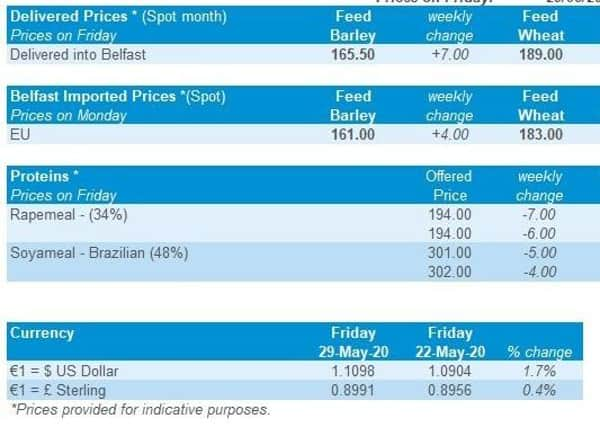Northern Ireland Weekly Market Report


Spring Planting and Variety Survey
The AHDB Spring Planting and Variety Survey provides the only pre-harvest planting view of grain and oilseed crops. Please help your industry to navigate these uncertain times by completing the planting survey form.
Strategic Farm Week 2020: 1-5 June
This year AHDB’s Strategic Farm Week will be delivered direct to your farm office. Watch from there, listen whilst crop walking and get involved.
Advertisement
Advertisement
We have brought together the research taking place on our Strategic Farms with our hosts, researchers and key experts from across the industry for a week of practical discussions, technical information and resources.
Find out about what’s taking place and when, and how to get involved.
Grains
Wheat
Crop concerns, especially in Europe, are still one of the driving forces supporting wheat prices currently. Longer-term support for prices depends on harvest confirming how yields have been impacted.
Maize
There are encouraging signs from the US ethanol sector but it won’t replace demand ‘lost’ in the past few months. With a large US crop expected, the market is still likely to be well supplied.
Barley
Advertisement
Advertisement
The potential impact of dry weather across Europe on both yields and quality is a key concern for markets at present, but it’s against a backdrop of uncertain demand and good prospects in Australia.
Global Markets
Global wheat markets were supported last week by continued dry weather across Europe, and some less than ideal forecasts for the US. The European Commission has cut 4.3 million tonnes from its wheat production estimate, from 125.8Mt to 121.5Mt. Last year the EU-27 harvested 130.8Mt.
Much of the Black Sea region received welcome rain last week, with more expected this week. Ukraine’s state weather forecaster pegs the 2020 crop at 23.3Mt vs 26Mt last year due to the impact of previous dry weather.
US ethanol stocks fell to their lowest level since January in the week ending 22 May, the US government revealed on Thursday. Ethanol production was also up for a fourth week running, indicating US maize demand is starting to recover. This data offered some support to maize prices last week, but gains were capped by worries about the trade relationship between the US and China.
Advertisement
Advertisement
A wetter than average winter is predicted in Australia, which would be positive for winter crops currently being planted and could support production in 2020/21. The proposed tariffs on Australian barley exports by China are likely to pose a price risk for UK barley prices, particularly in the second half of next season.
UK focus
UK wheat futures gained more than global levels due to sterling weakening against the euro and continuing worries about UK yields. However, it’s important to remember once UK prices reach the point at which imports become attractive, any further price gains are dependent on global markets.
UK 2019/20 end of season wheat stocks are forecast at 3.4Mt, potentially the largest end of season stocks on records dating back to 1999/00. A slow-down in the export pace post-October and the large 2019 crop have resulted in a large increase in stocks. Such a large carryout figure eases some of the pressure of the expected small 2020 crop, but UK supply and demand is still expected to be tight next season.
UK oat stocks are also forecast well above the 2014/15-2018/19 average of 158Kt at 291Kt, while the barley carry out is expected to hit 1.2Mt (up 11% from 2018/19).
Oilseeds
Rapeseed
Advertisement
Advertisement
Stratégie Grains cut its estimate of EU production, forecast to be the lowest since 2006, increasing the EU import requirement However, a plentiful global supply of soyabeans pressures markets.
Soyabeans
China reportedly pausing purchases of US soyabeans and other agricultural products creates further bearish sentiment. Argentine soyabean harvest reaches its fastest pace since 2012/13.
Global Markets
US soyabean futures (Nov-20) closed on Friday at $312.93/t, up by $2.66/t on 22 May. Throughout the week, this contract traded around the $314.00/t level before falling on Friday. This decline was ahead of a news conference by US President Trump, in which markets anticipated an escalation in disputes with China. This US escalation was not observed.
However, news this morning suggests state owned-Chinese trading firms were ordered to pause purchases of some US agricultural products, including soyabeans. US soyabean futures (nearby) has dropped $4.68/t between 8:00 and 13:00 GMT today. The latest intensification of US/China tensions puts ‘phase-one’ deal commitments for soyabean purchases in jeopardy.
Advertisement
Advertisement
Argentinian farmers have harvested 93% of the soyabean area as of 27 May, above the five year average of 81% for this point, and the fastest harvest pace since 2012/13. The crop is estimated at 49.5Mt. Argentine soyabeans reaching markets faster than expected will add to the large global supply already pressuring markets.
Malaysian palm oil futures (Jul-20) closed on Friday at their highest point since early-April, rising 17% over the course of May. Prices have been supported by a lower output this month and a resumption of purchases by India.
Rapeseed focus
Paris rapeseed futures (Nov-20) closed on Friday at €374.25/t, a loss of €5.25/t on the week. These declines filtered through to UK delivered rapeseed prices, with prices (into Erith) quoted at £330.00/t for harvest delivery, down £0.50/t. A further weakening of sterling against the euro, down 0.37%, prevented larger declines to UK prices.
Stratégie Grains has again lowered its EU rapeseed production estimate. The organisation now forecast a 16.7Mt crop, down from an estimate of 17.0Mt a month ago. These EU forecasts still include the UK. If realised, this would be below the 16.9Mt crop last year and the lowest figure since 2006.
The report highlighted that the ample canola supply in Canada and large soyabean supplies globally will cap EU rapeseed prices to an extent.